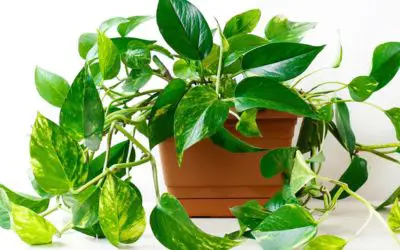Are you a pet owner who just got a new pothos plant? Or maybe you’ve had one for some time and now wonder if it could be hazardous to your four-legged companions.
Fret not, I understand that you want the best for both your furry friends and your beloved home greenery.
In this blog post, I’ll help you answer your question “Are Pothos toxic to dogs?” Read on to find out what is safe and unsafe regarding plants around pets.
Are Pothos Toxic to Dogs?
Yes, Pothos plants are toxic to dogs. This plant contains insoluble Calcium Oxalate crystals, which cause burning and irritation in the mouth and stomach of your dog. Symptoms of toxicity include drooling, vomiting, difficulty swallowing, and excessive licking at the affected area. In severe cases, it can even lead to difficulty breathing and seizures.
What is Pothos?
Pothos, also known as the Devil’s Ivy or Taro vine, is a popular indoor houseplant from the Araceae family.
It is native to the Solomon Islands but can be found in other countries such as Australia, Indonesia, and Malaysia.
This evergreen vine plant can grow up to 66 feet long with a moderate growth rate.
Pothos can be grown indoors or outdoors, but it thrives best in a warm, humid environment, making it perfect for your living room or office space.
When young, Pothos has heart-shaped, glossy green leaves with a distinctive pattern that resembles marble.
As it matures, the plant develops long, trailing vines with larger leaves that can grow up to 4 inches wide.
With its ability to purify the air and add a touch of natural beauty to any space, Pothos is a must-have for any plant lover.

Are Pothos Plants Toxic to Cats?
Unfortunately, yes. Pothos plants are toxic to cats. If cats consume any part of the plant, they may experience vomiting, diarrhea, increased salivation, and difficulty breathing.
In some cases, organ failure or death can occur if left untreated. It is best to keep pothos plants out of reach of cats at all times.
If your cat has ingested any part of the pothos plant, seek veterinary care immediately.

What is Pothos Poisoning
Pothos poisoning refers to the toxic effects that can occur when someone ingests or comes into contact with the sap of the Pothos plant (Epipremnum aureum).
The plant contains calcium oxalate crystals, which can cause irritation and inflammation of the mouth, tongue, and throat if ingested.
If a large enough amount is ingested, it can lead to more serious symptoms such as vomiting, diarrhea, abdominal pain, and difficulty breathing.
Contact with the sap can also cause skin irritation or a rash in some individuals or pets.
Symptoms may vary depending on the amount of plant material ingested or the duration and intensity of exposure to the sap.
If a pet or a person ingests or comes into contact with pothos, seek medical attention immediately.
Treatment may involve symptomatic care, such as pain relief and anti-inflammatory medication, and in severe cases, hospitalization and supportive care may be necessary.
How Poisonous is Pothos?
Pothos is mild to moderately toxic to pets and humans. Because they are so bitter, animals tend to eat only a small portion.
The level of toxicity depends on the amount of plant material ingested or the duration and intensity of exposure to the sap.
The calcium oxalate crystals, multiple glycosides, and saponins found in pothos irritate. If ingested, it may also lead to inflammation of the mouth, tongue, and throat.
In some cases, larger ingestion can lead to burning, swelling, vomiting, diarrhea, and abdominal pain.
What causes death after ingestion of this plant is asphyxiation and not necessarily the reaction.
What Toxin Does Pothos Contain?
Pothos contain calcium oxalate crystals, the primary toxin responsible for the plant’s toxicity.
These crystals are small, sharp, needle-like structures found in pothos leaves, stems, and roots.
When ingested or come into contact with, the calcium oxalate crystals can cause physical irritation and inflammation of the skin, mouth, and digestive tract, leading to burning, swelling, and difficulty swallowing.
Some pets and people may be more sensitive to the plant’s toxins than others. The severity of the symptoms also varies depending on the amount of plant material ingested or the duration and intensity of exposure to the sap.

What are the symptoms and severity of ingestion?
If you suspect your dog has ingested or come into contact with pothos, seek veterinary care immediately.
A veterinarian can diagnose pothos poisoning through a physical examination and any relevant medical history and symptoms the dog exhibits.
Diagnosis of Pothos poisoning
If you suspect your dog has ingested pothos, collect a plant material sample for your veterinarian to examine.
However, do not induce vomiting or give your dog any medication without consulting a veterinarian, as some treatments may worsen the symptoms.
Diagnosis of Pothos poisoning in dogs is done through a combination of physical examination, medical history, and any presenting symptoms.
During the physical examination, the veterinarian will check for any signs of inflammation or irritation in the mouth, throat, and digestive tract.
They may also check for any swelling or redness on the skin or other signs of allergic reaction or irritation.
The veterinarian may also ask about the dog’s recent diet and potential exposure to pothos or other toxic plants.
They may also perform blood tests and urinalysis to evaluate the dog’s organ function and check for potential complications.
In some cases, radiographs or other imaging tests may be necessary to evaluate the extent of any damage or inflammation in the digestive tract.
Medical signs
- Vomiting
- Diarrhea
- Abdominal pain or discomfort
- Depression
- Anorexia
- Lethargy
- Oral inflammation
- Foaming of the mouth
- Respiratory distress
- Irritation of the mouth, eyes, lips, and tongue
Behavioral signs
- Excessive drooling
- Agitation
- Lack of coordination or stumbling
- Shaking or trembling
- Inactivity and lack of interest in anything around them
- Excessive panting
- Abnormal vocalization, such as whining and moaning
- Seizures
What to do If Your Dog Eats Pothos
Before doing anything, you must be certain that your pet has eaten a pothos plant. Check on the plant for any signs of chewed leaves or missing pieces.
If you find evidence that your pet has eaten the pothos, start by administering first aid before seeking medical attention from a veterinary doctor.
First aid/At home care
The first care you need to give your dog after it has ingested pothos includes;
- Giving the dog analgesics
- Providing a small meal of bland food like boiled chicken and rice
- Ensuring the dog has access to plenty of fresh water
- Limiting their activity level so they rest more than usual
- Giving the dog antihistamines if they are experiencing any symptoms of allergic reaction

Veterinary Intervention
To treat your dog, the vet may:
- Administer charcoal to absorb the toxins in the plant material
- Induce vomiting to help expel the toxin from their system
- Provide electrolyte support and other medications to help the dog with any symptoms it may be experiencing
- Observe the dog for any changes in its behavior or health
- Perform a blood test to check for liver damage
- The veterinarian may also recommend supportive care depending on the severity of the situation. This could include hospitalization, fluid therapy, and nutrition
Recovery of Pothos Poisoning in Dogs
The recovery of a dog from pothos poisoning can vary depending on the severity of the exposure and how quickly the dog receives medical treatment.
Because most cases of pothos poisoning are relatively mild, recovery is usually quick and uneventful.
In severe cases, hospitalization may be necessary, where the dog can receive intravenous fluids, anti-nausea medication, and pain relief.
Once the dog is stabilized, the veterinarian may recommend a special diet or medication to help soothe the digestive tract and promote healing.
Most dogs will recover within a few days to a week with proper treatment and management.
Complications such as dehydration, kidney damage, or secondary infections may occur, prolonging recovery.
How do I Keep My Dog Away from Pothos?
You now know that your pothos can cause serious health issues for dogs, so take measures to keep your pet away.
Here are a few tips for keeping your dog away from pothos:
Keep pothos plants out of reach
Dogs can be so curious that they try to get into places they aren’t supposed to be. That’s why you need to keep pothos plants out of reach.
Consider placing it on a shelf or in an area your dog can’t access. Put them on a balcony if you have one or in an area blocked off from your pet.
Use barriers
If you cannot keep pothos plants out of reach, use barriers such as baby gates or fencing to block off the area where the plants are located.
This will help ensure your pet can’t get close enough to eat or chew on the plants. It will also help to keep children, who may be too curious for their own good, away from the plants.
Train your dog
Teach your dog basic obedience commands, such as “leave it” or “drop it,” which can discourage them from approaching or ingesting pothos plants.
Also, reward them with treats when they obey your commands. This will reinforce their good behavior and help ensure that they stay away from pothos plants in the future.
Provide alternative chew toys
Dogs are playful animals, and they love to chew. Pothos plants may also attract them due to their texture and scent.
To keep them away from pothos plants, provide them with plenty of safe chew toys such as rawhide bones or dental chews.
This will help satisfy their chewing needs and keep them away from the dangerous plant.
Use deterrent sprays
Several deterrent sprays on the market are designed to discourage dogs from chewing on plants. These sprays have a bitter taste that can help deter your dog from pothos plants.
However, these sprays can be toxic for dogs if ingested in large quantities. So, use them sparingly and as a last resort.
Consider using indoor plants that are safe for dogs
If you enjoy having plants in your home but are concerned about your dog’s safety, consider using indoor houseplants that are safe for dogs, such as spider plants or Boston ferns.
They can provide the same aesthetic benefits without posing a risk to your pet.
Supervise your dog
If your dog has access to outdoor areas where pothos plants may be present, such as parks or hiking trails, supervise them closely and discourage them from approaching any potentially toxic plants.
It’s also a good idea to carry a bottle of water with you on outdoor excursions if your pet ingests any potentially hazardous foliage.
Other Plants that Are Toxic for Your Cats and Dogs
Other common plants that can be toxic for cats and dogs include:
- Aloe Vera
- Asparagus Fern
- Azalea
- Begonia
- Peace Lily
- Jade plant
- Bird of Paradise
- Bittersweet
- Caladium
- Daffodil
- Dieffenbachia
- Fiddle leaf

Safe Alternatives to Pothos for Pet Owners
If you love plants and want your dogs to enjoy the same benefits, there are plenty of safe alternatives to Pothos that you can use in your home. Here are some ideas:
- Calathea
- Fishbone Cactus
- Burro’s Tail
- Ponytail Palm
- Peperomia
- Fan Palm
- Boston Fern
- Chinese Money Plant
- Spider Plant
- Prayer Plant
Why do Cats Eat Pothos?
Pothos plant contains chemicals attractive to cats, such as saponins and tannins. These substances give off a smell that cats find pleasing, making them more likely to want to eat the plant.
Cats also enjoy chewing on the soft and spongy pothos leaves, which can provide a satisfying texture.
Pothos also contains essential minerals and nutrients that cats may find beneficial.
Some cats enjoy batting at the leaves or chasing after them if the plant hangs from a hook or climbing trellis.
The interesting shapes of the leaves and stems may even entertain cats, further encouraging them to chew on the plant.
FAQs
Which pothos is pet safe?
The marbled and the green pothos are both pet safe. The marbled pothos has heart-shaped, variegated leaves with yellow, white, and green colors, while the green pothos has solid dark green foliage. Both varieties are non-toxic to cats and dogs and can thrive in varied light conditions.
Is golden pothos toxic to dogs?
Unfortunately, the answer is yes. According to the ASPCA, golden pothos is toxic to cats and dogs if ingested. Ingesting these plants can cause vomiting, drooling, and difficulty swallowing in animals. If your pet has eaten any parts of this plant, contact your veterinarian immediately. All parts of the golden pothos plant, including the leaves and stems, are toxic to animals.
Can pothos kill cats?
No, pothos can’t kill cats. However, if a cat eats the leaves or stems of pothos, it may experience some digestive upset, such as vomiting or diarrhea. If this occurs, take your cat to the vet immediately.
Is neon pothos toxic to cats?
Yes, neon pothos is toxic to cats. The plant contains insoluble calcium oxalates, which can cause irritation and swelling of the mouth, tongue, and throat. It can even lead to respiratory distress and difficulty swallowing in severe cases. If you suspect your cat has ingested some plants, contact your veterinarian immediately.
Is marble queen pothos toxic to cats?
No, marble queen pothos is not toxic to cats. This plant is part of the Araceae family and contains calcium oxalate crystals that can cause oral irritation if consumed in large amounts, but otherwise, it is not toxic. If your cat has ingested a significant amount of this plant, seek veterinary attention as soon as possible.
How much pothos is toxic to dogs
The threshold for pothos toxicity in dogs for pothos is unclear. However, it is best to err on the side of caution and keep all varieties of pothos plants out of reach from pets. Signs of poisoning can include vomiting, diarrhea, drooling, depression, anorexia, and tremors. If you suspect your pet has ingested any part of a pothos plant, contact your veterinarian immediately.
Is Monstera toxic to dogs?
Yes. Monstera is mildly toxic to dogs. It contains insoluble calcium oxalate crystals, which can irritate the mouth and stomach if consumed. If your dog has ingested Monstera, seek veterinary care immediately. Symptoms of ingestion may include drooling, vomiting, difficulty swallowing, oral irritation, and swelling of the lips or tongue.
Conclusion
Are pothos pet friendly? You now know the answer.
If you have pets and a pothos plant, keep an eye on them. Also, be careful when bringing new plants into your home.
Do research on any of the plants you may buy before making the purchase. That way, you will have knowledge of the toxicity level and how much maintenance it requires before having an unfortunate accident.
Before I conclude, there is still one question left unanswered. Why do Pothos droop?
The answer is actually quite simple. Pothos plants droop when they don’t receive enough water or light, so ensure you provide them with both.

